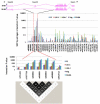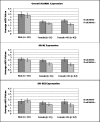Impact of gene variants on sex-specific regulation of human Scavenger receptor class B type 1 (SR-BI) expression in liver and association with lipid levels in a population-based study
- PMID: 20085651
- PMCID: PMC2822818
- DOI: 10.1186/1471-2350-11-9
Impact of gene variants on sex-specific regulation of human Scavenger receptor class B type 1 (SR-BI) expression in liver and association with lipid levels in a population-based study
Abstract
Background: Several studies have noted that genetic variants of SCARB1, a lipoprotein receptor involved in reverse cholesterol transport, are associated with serum lipid levels in a sex-dependent fashion. However, the mechanism underlying this gene by sex interaction has not been explored.
Methods: We utilized both epidemiological and molecular methods to study how estrogen and gene variants interact to influence SCARB1 expression and lipid levels. Interaction between 35 SCARB1 haplotype-tagged polymorphisms and endogenous estradiol levels was assessed in 498 postmenopausal Caucasian women from the population-based Rancho Bernardo Study. We further examined associated variants with overall and SCARB1 splice variant (SR-BI and SR-BII) expression in 91 human liver tissues using quantitative real-time PCR.
Results: Several variants on a haplotype block spanning intron 11 to intron 12 of SCARB1 showed significant gene by estradiol interaction affecting serum lipid levels, the strongest for rs838895 with HDL-cholesterol (p=9.2x10(-4)) and triglycerides (p=1.3x10(-3)) and the triglyceride:HDL cholesterol ratio (p=2.7x10(-4)). These same variants were associated with expression of the SR-BI isoform in a sex-specific fashion, with the strongest association found among liver tissue from 52 young women<45 years old (p=0.002).
Conclusions: Estrogen and SCARB1 genotype may act synergistically to regulate expression of SCARB1 isoforms and impact serum levels of HDL cholesterol and triglycerides. This work highlights the importance of considering sex-dependent effects of gene variants on serum lipid levels.
Figures




Similar articles
-
Functional genomics of the human high-density lipoprotein receptor scavenger receptor BI: an old dog with new tricks.Curr Opin Endocrinol Diabetes Obes. 2013 Apr;20(2):124-31. doi: 10.1097/MED.0b013e32835ed575. Curr Opin Endocrinol Diabetes Obes. 2013. PMID: 23403740 Free PMC article. Review.
-
Genetic contribution of SCARB1 variants to lipid traits in African Blacks: a candidate gene association study.BMC Med Genet. 2015 Nov 12;16:106. doi: 10.1186/s12881-015-0250-6. BMC Med Genet. 2015. PMID: 26563154 Free PMC article.
-
Impact of genetic variants in human scavenger receptor class B type I (SCARB1) on plasma lipid traits.Circ Cardiovasc Genet. 2014 Dec;7(6):838-47. doi: 10.1161/CIRCGENETICS.114.000559. Epub 2014 Sep 22. Circ Cardiovasc Genet. 2014. PMID: 25245032 Free PMC article.
-
Variants in scavenger receptor class B type I gene are associated with HDL cholesterol levels in younger women.Hum Hered. 2007;64(2):107-13. doi: 10.1159/000101962. Epub 2007 May 2. Hum Hered. 2007. PMID: 17476110 Free PMC article.
-
Estrogen regulation of the scavenger receptor class B gene: Anti-atherogenic or steroidogenic, is there a priority?Mol Cell Endocrinol. 2006 Mar 9;247(1-2):22-33. doi: 10.1016/j.mce.2005.10.005. Epub 2005 Nov 16. Mol Cell Endocrinol. 2006. PMID: 16297529 Review.
Cited by
-
A case-control analysis of common variants in GIP with type 2 diabetes and related biochemical parameters in a South Indian population.BMC Med Genet. 2010 Jul 30;11:118. doi: 10.1186/1471-2350-11-118. BMC Med Genet. 2010. PMID: 20673334 Free PMC article.
-
Gender and single nucleotide polymorphisms in MTHFR, BHMT, SPTLC1, CRBP2, CETP, and SCARB1 are significant predictors of plasma homocysteine normalized by RBC folate in healthy adults.J Nutr. 2012 Sep;142(9):1764-71. doi: 10.3945/jn.112.160333. Epub 2012 Jul 25. J Nutr. 2012. PMID: 22833659 Free PMC article.
-
Functional genomics of the human high-density lipoprotein receptor scavenger receptor BI: an old dog with new tricks.Curr Opin Endocrinol Diabetes Obes. 2013 Apr;20(2):124-31. doi: 10.1097/MED.0b013e32835ed575. Curr Opin Endocrinol Diabetes Obes. 2013. PMID: 23403740 Free PMC article. Review.
-
The Alzheimer's associated 5' region of the SORL1 gene cis regulates SORL1 transcripts expression.Neurobiol Aging. 2012 Jul;33(7):1485.e1-8. doi: 10.1016/j.neurobiolaging.2010.10.004. Epub 2010 Dec 23. Neurobiol Aging. 2012. PMID: 21185108 Free PMC article.
-
Scavenger receptor class B member 1 protein: hepatic regulation and its effects on lipids, reverse cholesterol transport, and atherosclerosis.Hepat Med. 2011 Apr 8;3:29-44. doi: 10.2147/HMER.S7860. Hepat Med. 2011. PMID: 24367219 Free PMC article. Review.
References
-
- Murao K, Terpstra V, Green SR, Kondratenko N, Steinberg D, Quehenberger O. Characterization of CLA-1, a human homologue of rodent scavenger receptor BI, as a receptor for high density lipoprotein and apoptotic thymocytes. J Biol Chem. 1997;272(28):17551–17557. doi: 10.1074/jbc.272.28.17551. - DOI - PubMed
-
- Trigatti BL, Rigotti A, Braun A. Cellular and physiological roles of SR-BI, a lipoprotein receptor which mediates selective lipid uptake. Biochim Biophys Acta. 2000;1529(1-3):276–286. - PubMed
Publication types
MeSH terms
Substances
Grants and funding
LinkOut - more resources
Full Text Sources
Research Materials

